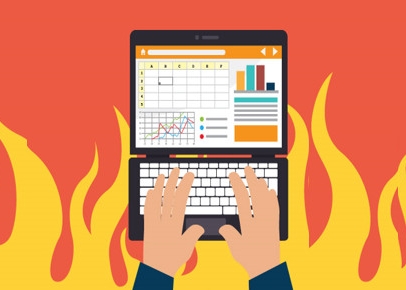
by Robyn Bolton | Aug 10, 2022 | Customer Centricity, Innovation, Tips, Tricks, & Tools
Between theory and practice is a nearly infinite chasm of superficial understanding and unearned confidence. This is no more true than in the case of Jobs to be Done (JTBD), and I can say that with confidence because I spent years in the chasm.
Years.
But I clawed my way up and out and experienced why JTBD is the single most powerful and transformative tool you can use to drive growth.
Want to skip the dive into the canyon and the long slow climb out?
What is Jobs to be Done (JTBD)?
A Job to be Done is a problem that a person is experiencing and/or progress a person wants to make in a given circumstance.
Although the origins of the phrase and theory are up for debate, many people point to Clayton Christensen, author of The Innovator’s Dilemma, as the originator of the phrase. (if you enjoy a good nerd-fight, and who doesn’t, you can read more from each person claiming to be The creator here, here, here, and here)
“The Milkshake Story” is an excellent example of JTBD. You can watch Clay tell it here. Or, remember the first, and still beautifully correct, articulation of JTBD, from a 1923 ad for a plumbing company in Reno, Nevada:
“When you buy a razor, you buy a smooth chin—but you could wear a beard.
When you buy a new suit, you buy an improved appearance—but you could make the old one do.
When you buy an automobile, you buy speedy transportation—but you could walk.
But when you buy plumbing, you buy cleanliness—for which there is no substitute!”
Why is JTBD so amazing?
Jobs to be Done surfaces the Why behind the What.
When you ask, “What do you want?” you’re asking people to define the solution. Whatever they say will be wrong because it is rooted in what exists. That’s why everyone from Henry Ford (supposedly) to Steve Jobs dismissed the usefulness of customer research.
If you ask the wrong question (What do you want?), you’ll get the wrong answer.
When you ask, “Why?” you’re asking people to define the problem. Whatever they say will be right (true) because it is rooted in their experience – the pain, frustration, and annoyance of today’s inadequate solutions.
Once you pair your understanding of why something works or doesn’t work with your knowledge of what is possible (not just what currently exists), then YOU are defining a solution that does its job better than anything else on the market.
When should you use Jobs to be Done?
Always. There is no “wrong” time to use it, and it’s valuable at every step of the innovation process:
- Discovery: Identify un- or under-served markets by finding important and unsatisfied JTBD
- Ideation, solution development, prototyping, market testing: Assess how well ideas solve important and unsatisfied JTBD and whether people are willing to pay for satisfaction
- Post-launch: Understand how JTBD are shifting in importance and satisfaction as new solutions enter the market and change the basis of competition
How to identify Jobs to be Done
Full disclosure, everything that follows sounds simple but is extremely challenging. I’ve trained hundreds of people in this process. 1% immediately do it well. At least 50% never figure it out. The other 49% of us practice every chance we get – from formal qualitative research to casual conversations with friends – and eventually, we get it.
Always start with one-on-one conversations because you don’t know what you don’t know (even if you think you know, trust me, you don’t). You’re going to ask questions that invite people to bare their souls and all of their quirks, and they will. But not if there’s a crowd.
- Identify no more than three questions that must be answered by the end of the conversation. Any more than that, you run the risk of the conversation becoming an interrogation, and no one will reveal their quirks and insecurities if they feel interrogated.
- Be human. Introduce yourself as a person (where you live, why you’re interested in speaking with them, what interests you about the topic), not as a professional (name, title, serial number). Humans want to connect with humans, not business cards.
- Be genuinely interested in the person you’re talking to. Ask them to introduce themselves and chime in when you find a shared interest. People will share more with you if you share with them.
- Ask only open-ended questions. People want to share their story. Let them. Don’t rush them. If they start to go off track, gently guide them back. This is about them, not you.
- Ask at least two follow-up questions. The first answer is never the real answer. It’s the answer they think you want to hear or the answer that puts them in the best light. Ask, “Why?” Say, “Tell me more.” Encourage with “And what else?” You’ll get the real answer only if you are patient and curious.
- Let the silence work for you. Ask the question and then stop talking. Don’t offer potential answers. Don’t explain the question. Just ask and shut up. In more Western cultures, silence is deeply uncomfortable, so people will do almost anything to fill it, including sharing their quirks and baring their souls. Sit and silently count to 8. Most people will start talking by five.
Once you identify Jobs to be Done, usually through approximately 10 JTBD conversations, you know what you don’t know. From here, you can use focus groups to refine your insights, surveys to quantify the market, or ideation sessions to develop solutions.
In conclusion
If you want to cross (or avoid) the chasm between reading about Jobs to be Done and using it as a tool to create value and growth, you’ve got to go beyond theory and DO the work.
As with all new skills, you’ll need to be bad at it before you can be good at it. But with practice, you WILL get good.
You may even use your deep understanding and well-earned confidence to help others make the crossing.

by Robyn Bolton | Jul 24, 2022 | Customer Centricity, Innovation, Leadership, Metrics, Stories & Examples, Strategy
Many years ago, Clay Christensen visited his firm where I was a partner and told us a story*.
“I imagine the day I die and present myself at the entrance to Heaven,” he said. “The Lord will show me around, and the beauty and majesty will overcome me. Eventually, I will notice that there are no numbers or data in Heaven, and I will ask the Lord why that is.”
“Data lies,” the Lord will respond. “Nothing that lies can be in Heaven. So, if people want data, I tell them to go to Hell.”
We all chuckled at the punchline and at the strength of the language Clay used (if you ever met him, you know that he was an incredibly gentle and soft-spoken man, so using the phrase “go to Hell” was the equivalent of your parents unleashing a five-minute long expletive-laden rant).
“If you want data, go to Hell.”
Clay’s statement seems absolutely blasphemous, especially in a society that views quantitative data as the ultimate source of truth:
- “In God we trust. All others bring data.” W. Edward Deming, founding Father of Total Quality Management (TQM)
- “Above all else, show the data.” – Edward R. Tufte, a pioneer in the field of data visualization
- “What gets measured gets managed” – Peter Drucker, father of modern management studies
But it’s not entirely wrong.
Quantitative Data’s blessing: A sense of safety
As humans, we crave certainty and safety. This was true millennia ago when we needed to know whether the rustling in the leaves was the wind or a hungry predator preparing to leap and tear us limb from lime. And it’s true today when we must make billion-dollar decisions about buying companies, launching products, and expanding into new geographies.
We rely on data about company valuation and cash flow, market size and growth, and competitor size and strategy to make big decisions, trusting that it is accurate and will continue to be true for the foreseeable future.
Quantitative Data’s curse: The past does not predict the future
As leaders navigating an increasingly VUCA world, we know we must prepare for multiple scenarios, operate with agility, and be willing to pivot when change happens.
Yet we rely on data that describes the past.
We can extrapolate it, build forecasts, and create models, but the data will never tell us with certainty what will happen in the future. It can’t even tell us the Why (drivers, causal mechanisms) behind the What it describes.
The Answer: And not Or
Quantitative data Is useful. It gives us the sense of safety we need to operate in a world of uncertainty and a starting point from which to imagine the future(s).
But, it is not enough to give the clarity or confidence we need to make decisions leading to future growth and lasting competitive advantage.
To make those decisions, we need quantitative data AND qualitative insights.
We need numbers and humans.
Qualitative Insight’s blessing: A view into the future
Humans are the source of data. Our beliefs, motivations, aspirations, and actions are tracked and measured, and turned into numbers that describe what we believed, wanted, and did in the past.
By understanding human beliefs, motivations, and aspirations (and capturing them as qualitative insights), we gain insight into why we believed, wanted, and did those things and, as a result, how those beliefs, motivations, aspirations, and actions could change and be changed. With these insights, we can develop strategies and plans to change or maintain beliefs and motivations and anticipate and prepare for events that could accelerate or hinder our goals. And yes, these insights can be quantified.
Qualitative Insight’s curse: We must be brave
When discussing the merit of pursuing or applying qualitative research, it’s not uncommon for someone to trot out the saying (erroneously attributed to Henry Ford), “If I asked people what they wanted, they would have said a horse that goes twice as fast and eats half as much.”
Pushing against that assertion requires you to be brave. To let go of your desire for certainty and safety, take a risk, and be intellectually brave.
Being brave is hard. Staying safe is easy. It’s rational. It’s what any reasonable person would do. But safe, rational, and reasonable people rarely change the world.
One more story
In 1980, McKinsey predicted that the worldwide market for cell phones would max out at 900,000 subscribers. They based this prediction on solid data, analyzed by some of the most intelligent people in business. The data and resulting recommendations made sense when presented to AT&T, McKinsey’s client.
Five years later, there were 340,213 subscribers, and McKinsey looked pretty smart. In 1990, there were 5.3 million subscribers, almost 6x McKinsey’s prediction. In 1994, there were 24.1M subscribers in the US alone (27x McKinsey’s global forecast), and AT&T was forced to pay $12.6B to acquire McCaw Cellular.
Should AT&T have told McKinsey to “go to Hell?” No.
Should AT&T have thanked McKinsey for going to (and through) Hell to get the data, then asked whether they swung by earth to talk to humans and understand their Jobs to be Done around communication? Yes.
Because, as Box founder Aaron Levie reminds us,
“Sizing the market for a disruptor based on an incumbent’s market is like sizing a car industry off how many horses there were in 1910.”
* Except for the last line, these probably (definitely) weren’t his exact words, but they are an accurate representation of what I remember him saying

by Robyn Bolton | Apr 25, 2022 | Customer Centricity, Innovation
I love engineers*
Engineers are the ultimate problem-solvers. They see a problem and the need to fix it. Engineers believe every solution can be improved, every process can be more efficient, and every system optimized.
Which is why I nearly fell out of my chair when, after explaining (again) the importance of asking 5 Whys when interviewing customers and asking why the team was struggling to do so, an engineer said,
“We troubleshoot the why. Asking would be a show of not knowing.”
Wha?!?!?
In my head, I screamed, “But we don’t know! We don’t know the problem because the customer defines the problem! But people are terrible at defining problems, so we ask why. So that we can understand the root cause, then articulate the problem, then solve it!”
Instead of actually screaming, I took a deep breath and said, “Mmmmmm, interesting.”
Admittedly, not the most helpful response.
Why Asking “Why?” is hard
How often do you ask, “Why?”
How often do people on your team ask, “Why?”
Probably not often and probably for reasons that feel very sensible:
- It’s my job to know why
- I don’t want people to think I don’t know
- I don’t know, but I think I should
- People will think I’m stupid/not good at my job
- I’ll lose credibility, and that will impact my job/job prospects/paycheck
And, let’s be honest, those reasons are quite sensible depending on the circumstance.
But feelings aren’t facts, and I still didn’t understand why problem-solvers struggled to ask, “Why?”
So, I sought out an engineer and asked, “Why?”
He took a deep breath and said, “Mmmmmm, it’s complicated.”
When asking “Why?” should be hard.
There are lots of different types of engineers, but when you focus on engineers working in companies (as opposed to those in academia or research labs), most of them work on machines, code, systems, or processes, that exists or are knowable.
In this context, when there’s a problem, it’s the engineer’s job to identify why the problem occurred and how to fix it.
To troubleshoot the Why, engineers use tools specifically designed to collect and analyze data. While those tools aren’t perfect, engineers know how to calibrate the data by applying different allowances and tool combinations.
“So,” I summarized, “when you’re dealing with something objectively knowable, like a machine or code, and you have a proven tool for troubleshooting, you shouldn’t ask, ‘Why?’ Right?”
“Sure,” replied the engineer, who is very used to me over-simplifying things and knows better than to try to convince me that his long and complicated answer is a better way to go.
When asking “Why?” should be easy
Humans can also be thought of as machines, code, systems, and processes, but, unlike those that engineers work on, we’re not objectively knowable. As neuroscientist Antonio Damasio wrote, “We are not thinking machines. We are feeling machines that think.”
In this context, when a human has a problem, the human is the only one who knows why the problem occurred. This means that we must find the Why before we can troubleshoot it.
Finding the Why and troubleshooting in this circumstance is challenging because we don’t have tools specifically designed to collect and analyze data. We ARE the tools. We must ask the right questions and listen without assuming or interpreting to ensure that we get accurate answers.
How to make asking “Why?” easier
As a problem-solver, it’s always essential that you find the root cause.
How you find that root cause varies.
If the problem is occurring in something that is objectively knowable and accurately measured and assessed with proven tools, then yes, it IS your job to know why there’s a problem and troubleshoot it.
If the problem is occurring in something not objectively knowable (like a human), then it is your job to ask Why (usually several times) before you troubleshoot.
After all, even if you’re an engineer, you can’t solve a problem if you don’t know why it exists.
* I’m married to an engineer, but that’s not the only reason I love them

by Robyn Bolton | Mar 23, 2022 | Customer Centricity, Innovation, Stories & Examples
“He’s just not that into you.”
That sentence is usually uttered as tough-love advice to a friend who can’t seem to let go of a guy that’s clearly let go of her. A few weeks ago, it was tough love advice to one of my friends who couldn’t understand why customers weren’t swooning over his company’s newest product.
They didn’t hate.
But most didn’t like it enough to buy it.
It wasn’t rejection that was killing the business. It was apathy.
It was painful to witness.
It is also solvable.
Breeding apathy
I’m a baseball fan. I’m also the first to admit that baseball breeds apathy amongst its fans.
4-hour games. At-bats that feel like 4 hours. Fan involvement that is limited mainly to the Wave and the 7th Inning Stretch. It’s boring.
Unless you’re in Savannah, GA.
If you’re in Savannah to see baseball, you show up 2 hours before the game starts. When the gates open, you rush to your seats because you don’t want to miss a moment of the pre-game festivities. During the game, you bounce in and out of your seat so much that it counts as a workout. After the game, you spend another hour dancing and singing with the band and the team. By the time you get home, your voice is hoarse, your head is spinning, and you swear you never knew a baseball game could be so fun.
It’s bananas. The Savannah Bananas.
Converting the apathetic into raving fans
How do they do it?
How does a collegiate summer baseball team sell out every game since 2016 and routinely attract people from around the world?
More importantly, what can you (and my friend) learn from them?
1. Do Your (customers’) Job (to be Done).
Most people go to baseball games to have fun and make memories. Most MLB franchises are focused on making a profit and winning trophies. Not a whole lot of overlap there.
The Bananas promise “to provide an electric atmosphere at all of our games! Our fans come first, and we’re dedicated to entertaining you!” There’s a complete overlap between what the fans want – have fun and make memories – and what the Bananas offer.
2. Deliver an end-to-end experience
For most businesses, designing and delivering an end-to-end experience is about investing in technology to make buying their products “frictionless” and training customer service to be more “helpful.”
The Bananas invest in delivering delight. Here’s what happened after I spent a whopping $50 to buy two tickets:
- I received an email telling me I had just made the “best decision of my life” and sharing a video of the “live” view of their offices when my order came in (dancing and chaos)
- Three days later, Carson called to thank me for buying tickets
- Two weeks before the game, they emailed to help me “mentally prepare” for the experience.
- One week before the game, they sent a permission slip to give to my boss to get out of work early.
- On gameday, they emailed a Spotify playlist so we could prepare for the game
- The day after, they emailed a handwritten thank you note from the owners
- A week after the game, they emailed a video montage of the game we attended
3. Be human
Most companies “run lean” and use technology to improve efficiencies because humans are expensive.
The Bananas are human. Carson emailed the permission slip. She also called to thank me for buying tickets. Nick sent the gameday email. He also gave me the wristband required to get to our seats. The owner, Jesse Cole, spent the night running around in a yellow tuxedo hyping up the crowd. His wife wrote a thank you letter.
4. Give thanks. No strings attached
We’ve all received the “Thank You for Your Purchase” email after an online transaction. We also know that the email will ask for something more – track your package, write a review, post on social media, buy another product.
The Bananas say, “Thank You,” then give you something more – a funny video, a permission slip, a Spotify playlist, a handwritten thank you note. They don’t ask you to buy merchandise or post about your experience on social media, or leave them a review.
5. Care
If you don’t care about your product, no one else will.
In a world of baseballs, be a banana.
There are dozens of other things the Savannah Bananas do that make them unique and delightful that your business (and MLB) would struggle to copy.
But there are at least five things you can copy to stave off customer apathy and inspire die-hard, life-long, “tell all your friends” loyalty.
What did I miss? What have YOU experienced or done to be a banana?

by Robyn Bolton | Jan 4, 2022 | Customer Centricity, Innovation, Tips, Tricks, & Tools
Before we go any further, I need to be clear that I absolutely, totally, and completely believe in Jobs to be Done. In fact, more than once, I have uttered the words, “Jobs to be Done is a hill I will die on.”
Which means that I died a little inside when a client recently said to me,
“Jobs to be Done is amazing. ‘Jobs to be Done’ sucks.”
He’s right (as much as it kills me to admit that).
In an academic setting, the term makes perfect sense.
I understand where the term comes from and applaud the logic and clarity of the analogy at its core. Just as a company hires a person for a task or set of functions (a job), a person “hires” a product or service because they have a problem to solve or progress they need to make. They have a Job to be Done.
Managers and executives who work with me to learn Jobs to be Done and how to apply it quickly grasp the concept. After just one-hour, they can re-tell and explain the Milkshake story, identify functional/emotional/social jobs in role plays, and swear that the approach completely changes how they see and think about their business.
In the real world, the term is profoundly confusing.
Then the managers and executives, believing so strongly in its ability to transform the business, decide to roll it out to the organization. They talk about it, send articles about it, and train everyone to apply it in customer interviews. With great excitement, everyone from employees to senior leaders fan out to talk to customers, take copious notes, discuss insights with their teams, and happily declare that their customers’ Jobs to be Done are to buy the company’s products.
Here’s a quick (and entirely fictional) example:
- Chocolate Chip Cookie Company (CCCC): Hello, Ms. Customer. We want to learn more about your snacking habits. When you snack and why, what you like to snack on and why, stuff like that.
- Customer: Great! I love to snack on chocolate chip cookies, but the store-bought ones are expensive, and they’re filled with preservatives, and I’m trying to be healthier. I’d make my own, but I don’t have time.
CCCC returns to the office and declares that the customer’s Job to be Done is to buy cheap all-natural cookies from a store.
Ummm, no. Not even close.
The customer’s Jobs to be Done are to be healthy, manage her money, save time, and feel good about what she eats. CCCC’s job (literally, the company’s reason for business) is to make cookies that customers want to buy.
What CCCC identified as a customer Job to be Done is the company’s job (business). In other words, it’s a solution.
Why the confusion?
In the real world, people already have precise definitions of “job” in their heads. They have a job (role). They have a job to do (responsibilities, deliverables). Their colleagues have jobs (roles and responsibilities). They have job openings (hiring needs).
By assigning a new meaning to the word “job,” we’re not only asking people to change how they think and talk, but we’re also asking them to adopt an entirely new understanding of and use for a common word.
Imagine being told that “orange” means both a color and a cooking technique. It makes the brain hurt.
What’s the solution?
I don’t know. But here’s what I’ve tried.
- Problem
- Pro: It’s part of the definition of a Job to be Done, and we all know what a problem is
- Con: It focuses customer conversations on existing pain points and sets a negative tone in interviews, making it challenging to discover solutions that delight the customer and, as a result, could inform how the problem is solved.
- Need
- Pro: It’s the OG of consumer research, a term we all know and use
- Con: It anchors customer conversations in functional Jobs to be Done and makes it difficult to surface the emotional and social Jobs that drive decisions and behavior.
- Customer Job to be Done
- Pro: Uses the original term while being VERY clear that the focus is on the customer
- Con: It’s a lot to say and even more to type, and people still fall back into their traditional definitions and use of the term job
What have you tried? What are your suggestions?

by Robyn Bolton | Aug 26, 2020 | Customer Centricity, Tips, Tricks, & Tools
“When you say, ‘uh-huh’ over and over like that, I can tell you’re not listening to me.”
Me, age 7, to my mom
It doesn’t take a lot of experience to know when someone isn’t listening. From a young age, we can tell when someone is listening and when they’re simply responding.
When we’re with the person, we notice the lack of eye contact or the blankness in their eyes showing us where their thoughts are actually at. When we’re on the phone, we hear the repetitive and monotone mumbles that tell us they’re attention is elsewhere.
Yet often, what we want most is simply to be listened to.
This is true in our personal relationships and in our relationships with the businesses and organizations we support. We want people and businesses to listen to our opinions, to understand them, and to thoughtfully respond to them.
Instead, people and businesses simply “hear” us.
There’s a big difference between listening and hearing
According to the Oxford University Press, hearing is “the faculty of perceiving sounds” while listening is “give one’s attention to a sound” and “take notice of and act on what someone says.”
As I explain to my clients, surveys, focus groups, and even in-depth qualitative research is often a Hearing exercise – the company develops a list of questions, asks their customers to answer the questions, then tabulates the answers and passes them along to whoever needs them.
This is a transaction. An exchange of information. It is not listening.
Listening requires engagement. It happens during EPIC conversations, those typified by empathy, perspective, insights, and connection.
Listening accelerates innovation and drives transformation. When we’re listening, we’re learning new information and discovering new insights, which enables companies to create and act differently, differentiating themselves from the competition and ultimately gaining an advantage.
Listening takes practice but here are 5 simple steps to help you get started:
- Drop the agenda – Before you have a conversation within someone, identify the 1-3 things you need to learn and leave space for at least 1 surprise. If you go into a conversation with an agenda or a long list of questions, you’re only going to hear what you want to hear because your mind is primed to seek confirmation for your opinions and to reject anything counter to what you’re hoping to hear.
- Follow where they lead – During the conversation, don’t worry about trying to steer the conversation or “keep things on track.” If you only need to learn 3 things in the conversation and you have 30 minutes or an hour, you have plenty of time for tangents, stories, and random connections. This is where the surprises and the insights come from.
- Ask Why – Channel your inner two-year-old (or Toyota Production employee) and ask “Why” multiple times. When you ask “Why” you get personal, surprising answers that point to the motivations behind people’s choices and actions. When you ask “What” you get rational, expected, even obvious answers that you, and your competitors, have heard before.
- Say as little as possible – Follow the 80/20 rule and spend 80% of your time listening. When you ask a question, don’t go into a long pre-amble about why you’re asking it or follow it with a long list of options or examples. Simply ask the question and the answer will come.
- Let the silence work for you – After you ask a question, start counting silently in your head. Before you get to 8, the person you’re listening to will start talking. Silence makes people uncomfortable but it’s also when the brain goes into exploration and discovery mode. And the longer the silence goes on, the faster the brain works to come up with something to fill it. So, stay quiet and let the brain work!
Whether you’re talking to a customer, a colleague, or a friend, you’re talking to someone who wants you to listen, to hear and understand what they are saying. These 5 tips will help you do that and, if done well, discover something wonderful and unexpected with the power to transform.
Originally published on April 20, 2020 on Forbes.com





